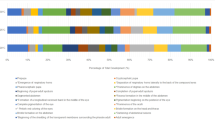Abstract
Forensic entomology is a study that insect evidence is used for the determination of postmortem interval (PMImin). While determining PMImin, the pupal period is given as the duration between the beginning of the pupal period and the stage of adult emergence. The pupal period constitutes approximately 50 % of the immature development, and with detailed examination it would be possible to present a much more accurate PMImin. In this study, the pupal period of Lucilia sericata (Meigen, 1826), which is one of the species used in PMImin estimation in forensic entomology, was investigated. Studies about the pupal period of development are considerably limited in the forensic entomology world. Stages and duration of the pupal period of Lucilia sericata were studied at temperatures of 20 °C, 25 °C, and 30 °C. For all temperatures, pupae specimens were dissected and photographed hourly. According to findings based on all three temperatures, it was determined that as the temperature increases, the duration of development shortens. Also, in addition to 11 pre-determined development stages, nine new development stages were identified.





















Similar content being viewed by others
References
Goff ML (2001) A fly for the prosecution: how insect evidence helps solve crimes. Harvard University Press, Cambridge
Şabanoğlu B (2007) Determination of Calliphoridae (Diptera) Fauna on Carrion and Morphological Studies in the Point of Systematic Aspect in Ankara Province. Dissertation, Hacettepe University, Institute of Graduate Studies in Science
Adams ZJO, Hall MJR (2003) Methods used for killing and preservation of blowfly larvae and their effect on post mortem length. Forensic Sci Int 138(1–3):50–61
Amendt J, Kretteck R, Zehner R (2004) Forensic entomology. Naturwissenshaften 91:51–65
Grassberger M, Reiter C (2001) Effect of temperature on Lucilia sericata (Diptera:Calliphoridae) development with special reference to the isomegalen and isomorphen-diagram. Forensic Sci Int 120:32–36
Greenberg B, Kunich JC (2002) Entomology and the law: flies as forensic indicators. Cambridge University Press, Cambridge, p 306
Mandeville DJ (1988) Rearing Phaenicia sericata (Diptera: Calliphoridae) on dry cat food with CSMA. J Med Entomol 25(3):197–198
Şabanoğlu B, Sert O (2010) Determination of Calliphoridae (Diptera) fauna and seasonal distribution on carrion in Ankara province. J Forensic Sci 55:1003–1007
Tantawi TI, Greenberg B (1993) The effects of killing and preserving solutions on estimates of larval age in forensic cases. J Forensic Sci 38:303–309
Zehner R, Amendt J, Boehme P (2009) Gene expression analysis as a tool for age estimation of blowfly pupae. For Sci Int Genet Suppl 2:292–293
Agrel IPS, Lundquist AM (1973) Physiological and biochemical changes during insect development. In: Rockstein M (ed) The physiology of insecta. Academic, New York
Finell N, Jarvilehto M (1983) Development of compound eyes of the blowfly Calliphora erythrocephala: changes in morphology and function during metamorphosis. Ann Zool Fenn 20:223–234
Brown KE (2012) Utility of the Calliphora vicina (Diptera: Calliphoridae) Pupal Stage for Providing Temporal Information for Death Investigations. Dissertation, University of Portsmouth
Zajac BK, Amendt J (2012) Bestimmung des Alters Forensisch Relevanter Fliegenpuppen. Rechtsmedizin 22:456–465. doi:10.1007/s00194-012-0854-5
Ergil C (2012) The Analysis of Pupal Developments in Calliphora vomitoria (Linnaeus, 1758) and Chrysomya albiceps (Wieddemann, 1819) Species which Belong to Calliphoridae Family that is Among the Forensically Important Insect Groups. Dissertation, Hacettepe University, Institute of Graduate Studies in Science
Zumpt F (1965) Myiasis in man and animals in the old world. Butterworths, London
Catts EP, Haskell NH (1990) Entomology and death: a procedural guide, 1st edn. Joyce’s Print Shop, South Carolina, pp 1–182
Richards CS, Simonsen TJ, Abel RL, Hall MJR, Schwyn DA, Wicklein M (2012) Virtual forensic entomology: improving estimates of minimum post-mortem interval with 3D micro-computed tomography. For Sci Int 220(1–3):251–264. doi:10.1016/j.forsciint.2012.03.012
Acknowledgments
We would like to thank Assoc. Prof. Dr. Hilal Özdağ from the Ankara University Institute of Biotechnology for proofreading and corrections. We also would like to thank Res. Assist. Dr. Burcu Şabanoğlu and Res. Assist. Dr. Senem Firat, and appreciate their help.
Conflict of interest
The authors declare that they have no conflicts of interest.
Author information
Authors and Affiliations
Corresponding author
Additional information
This article is the main part of Tuçe Karabey’s master thesis, which was supervised by Assoc. Prof. Dr. Osman Sert and accepted on 11 April 2012.
Rights and permissions
About this article
Cite this article
Karabey, T., Sert, O. The analysis of pupal development period in Lucilia sericata (Diptera: Calliphoridae) forensically important insect. Int J Legal Med 132, 1185–1196 (2018). https://doi.org/10.1007/s00414-014-0968-2
Received:
Accepted:
Published:
Issue Date:
DOI: https://doi.org/10.1007/s00414-014-0968-2




